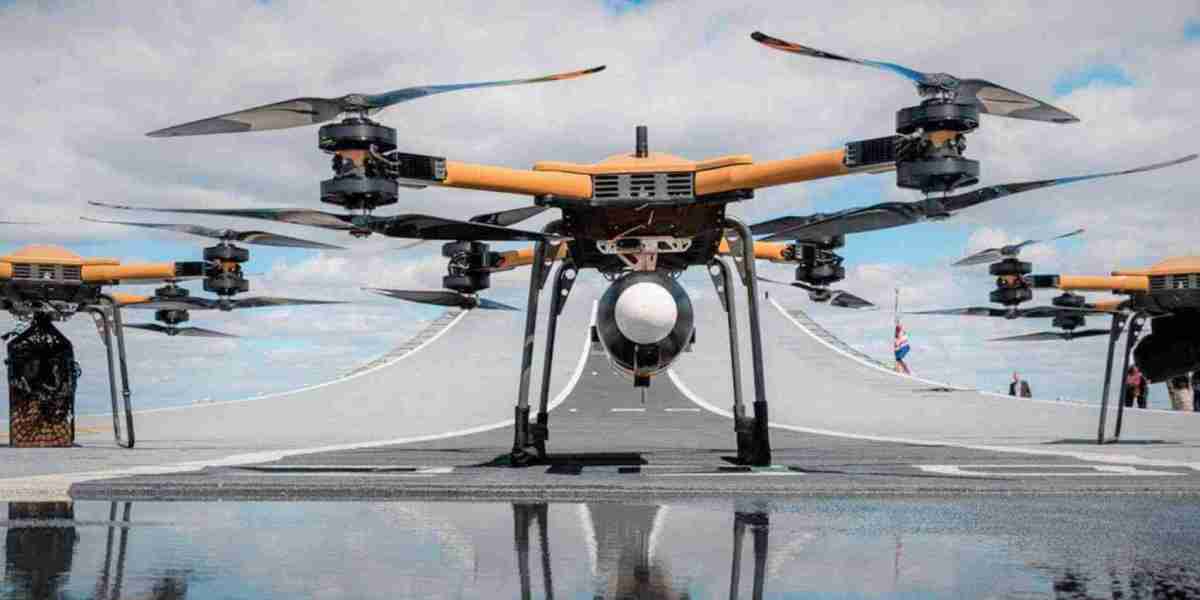The heavy-lift cargo drone market is evolving rapidly as companies seek to revolutionize logistics and air cargo transport with unmanned aerial vehicles (UAVs). The industry is driven by technological advancements, increasing demand for faster deliveries, and the need for more efficient supply chains. As competition intensifies, companies are leveraging various strategies and innovations to stay ahead in the market. This article explores the competitive strategies and innovations shaping the heavy-lift cargo drone market and positioning key players for future growth.
1. Technological Innovation: Enhancing Drone Capabilities
The heavy-lift cargo drone market is highly competitive, and technological innovation is at the forefront of strategies aimed at achieving operational efficiency, increasing payload capacities, and expanding flight range. Companies are investing heavily in R&D to push the boundaries of drone technology.
Key Innovations in Drone Technology:
- Autonomous Flight Systems: Leading players are focusing on developing autonomous flight systems that enable drones to operate without human intervention. AI-powered navigation, obstacle detection, and real-time decision-making capabilities are essential for improving operational efficiency and safety.
- Battery Technology: Advances in battery technology are critical to increasing flight time and payload capacity. Companies are exploring electric, hybrid, and solar-powered drones to ensure longer operational hours and reduced energy consumption.
- Modular Payload Systems: Innovations in modular payload systems allow heavy-lift drones to carry various types of cargo, from medical supplies to e-commerce packages, enhancing their versatility and expanding market opportunities.
Example of Innovation:
- Amazon Prime Air has been investing in autonomous drone technology to develop systems that can fly longer distances, carry heavier payloads, and navigate complex environments autonomously. Their use of AI for route optimization and real-time adjustments is central to their competitive edge.
2. Strategic Partnerships and Collaborations
Partnerships are a key competitive strategy for companies looking to expand their market reach, improve operational capabilities, and secure resources for innovation. Strategic collaborations with tech companies, logistics providers, and government bodies are essential to overcoming regulatory challenges and achieving scalability in drone operations.
Key Collaborations:
- Logistics and E-Commerce Partnerships: Companies like UPS and DHL have partnered with e-commerce giants, such as Amazon and Walgreens, to implement drone solutions for last-mile deliveries. These collaborations enable large-scale testing and operational deployment of heavy-lift drones, increasing efficiency and reducing costs.
- Regulatory Partnerships: Partnering with government bodies like the FAA (Federal Aviation Administration) in the U.S. or the European Union Aviation Safety Agency (EASA) is critical for gaining regulatory approvals and ensuring safe drone operations.
- Industry-Specific Collaborations: Companies are also forming partnerships within specific industries, such as healthcare and agriculture, to meet specialized needs. Zipline, for example, has collaborated with GAVI to deliver medical supplies and vaccines using drones in developing regions.
Example of Partnership:
- UPS and CVS are working together to develop drone-based solutions for the rapid delivery of medical supplies and prescription drugs, particularly in remote areas or during emergencies. This partnership strengthens UPS’s presence in the healthcare sector while expanding CVS's reach for on-demand deliveries.
3. Focus on Sustainability and Environmental Impact
As sustainability becomes a priority for consumers and investors, companies in the heavy-lift cargo drone market are focusing on environmentally friendly innovations. Drones, which are inherently more energy-efficient than traditional transportation methods, offer a sustainable alternative for cargo delivery.
Key Sustainable Strategies:
- Electric and Hybrid Drones: Many companies are moving toward electric and hybrid-powered drones to reduce carbon emissions. Electric drones have fewer moving parts, lower maintenance costs, and a smaller environmental footprint compared to fossil fuel-powered alternatives.
- Energy-Efficient Flight Paths: Companies are also developing flight path optimization technologies that reduce fuel consumption and enhance battery life, improving the overall energy efficiency of drone operations.
- Carbon Offset Initiatives: Some companies are implementing carbon offset programs to balance out emissions from their drone fleets, aligning with global sustainability goals.
Example of Sustainability Focus:
- EHang, a leading autonomous drone company, focuses on developing eco-friendly drones that use electric propulsion, reducing reliance on traditional fuel-based transport and minimizing emissions.
4. Regulatory Compliance and Advocacy
Navigating regulatory environments is one of the biggest challenges in the heavy-lift cargo drone market. Companies are prioritizing compliance with aviation laws and working closely with regulatory authorities to ensure the safe and legal operation of drones.
Key Regulatory Strategies:
- Advocacy for Drone Integration: Many companies, including Amazon and UPS, are actively engaging with regulatory bodies to help shape drone policies that will support the growth of the market. Their lobbying efforts focus on issues such as airspace integration, safety standards, and certification procedures.
- Collaboration with Aviation Authorities: Companies are collaborating with aviation authorities worldwide to gain approvals for their drone operations. For example, the FAA’s Part 135 certification process has been a critical step for many drone companies to gain commercial operating approval.
- Development of Air Traffic Management Systems: Companies are working on developing air traffic management systems for drones, ensuring they can safely share airspace with manned aircraft.
Example of Regulatory Advocacy:
- Amazon Prime Air has been working with the FAA to gain regulatory approvals for the operation of drones in the U.S., with a focus on expanding delivery capabilities while ensuring safety. Their efforts include advocating for clearer regulations surrounding drone delivery operations.
5. Market Diversification and Expansion
As the heavy-lift cargo drone market matures, companies are diversifying their portfolios and expanding into new industries to capture a larger share of the market. Heavy-lift drones are being used for more than just logistics; they are also finding applications in sectors like healthcare, disaster relief, and agriculture.
Diversification Strategies:
- Healthcare Applications: Companies like Zipline and UPS are focusing on the healthcare sector, using drones to deliver critical medical supplies, blood, and vaccines. This diversification opens up new revenue streams and expands drone use cases.
- Agricultural Solutions: Drones are being used in agriculture to deliver supplies such as seeds, fertilizers, and pesticides. Companies are developing heavy-lift drones tailored to meet the specific needs of the agriculture industry.
- Disaster Relief and Humanitarian Aid: Heavy-lift drones are being used to deliver aid in disaster-stricken areas, where traditional transportation options are limited. This application opens new opportunities for companies to enter humanitarian aid markets.
Example of Market Diversification:
- Zipline has expanded its services beyond medical supply deliveries in Rwanda to include vaccine distribution in Ghana and remote blood deliveries in the Philippines. This diversification strategy has enabled Zipline to expand its operational footprint and increase the relevance of heavy-lift drones in global supply chains.
6. Cost Efficiency and Scalability
In a competitive market, reducing operational costs while scaling up drone fleets is crucial. Companies are focusing on developing cost-efficient solutions that make drone technology more accessible to a broader range of customers, from small businesses to large enterprises.
Cost-Cutting Innovations:
- Automated Drone Maintenance: To reduce maintenance costs, companies are developing automated systems for monitoring drone performance and conducting repairs. This approach reduces downtime and minimizes the need for manual labor.
- Scalable Drone Solutions: Companies are offering scalable drone systems that can be adapted for different payloads and delivery distances, making them more cost-effective for various industries.
Example of Cost Efficiency Focus:
- UPS Flight Forward has been developing a scalable drone delivery system that can handle a range of payloads and distances, making it easier for the company to expand its drone fleet and lower operational costs while increasing efficiency.
Final Thoughts
The heavy-lift cargo drone market is highly competitive, with companies deploying a variety of strategies to gain market share and innovate in the industry. Key strategies include technological advancements in drone systems, strategic partnerships, sustainability initiatives, regulatory advocacy, and market diversification. By focusing on these areas, companies are positioning themselves to lead the market, offering more efficient, cost-effective, and innovative solutions to meet the growing demand for drone-powered logistics and cargo transportation.




